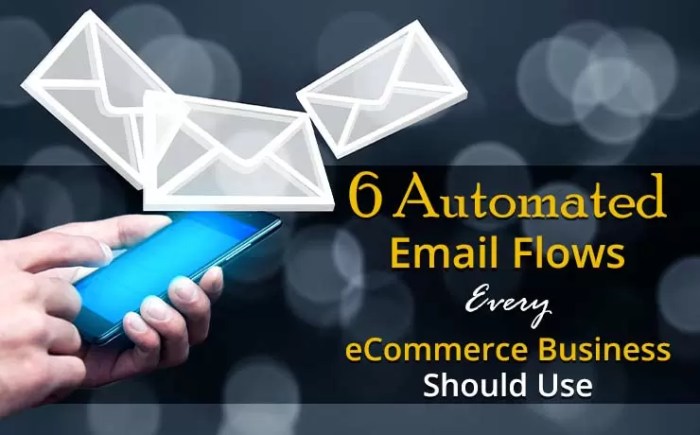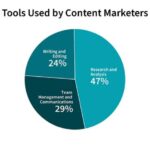Automated e commerce emails – Automated e-commerce emails are revolutionizing customer engagement. From welcome messages to abandoned cart reminders, these automated messages play a crucial role in driving sales and fostering customer loyalty. This guide delves deep into the world of automated e-commerce emails, exploring everything from defining different email types to analyzing performance metrics, integrating automation with other channels, and addressing common challenges.
We’ll also touch on future trends and how AI is transforming this space.
This in-depth exploration of automated email marketing strategies will equip you with the knowledge to create effective campaigns that boost conversions and enhance the customer experience.
Defining Automated E-commerce Emails

Automated emails are a cornerstone of modern e-commerce, significantly boosting customer engagement and driving sales. They’re pre-programmed messages triggered by specific customer actions or predefined schedules. This automated approach allows businesses to nurture leads, streamline communication, and personalize interactions with customers, all while saving valuable time and resources.Automated emails provide a crucial touchpoint for customers throughout their journey, from initial interest to post-purchase follow-up.
They help businesses efficiently manage customer relationships, and are particularly effective when tailored to specific user actions or milestones.
Types of Automated E-commerce Emails
Automated emails come in various forms, each designed to cater to different stages of the customer journey. These emails are not just transactional; they’re personalized interactions that foster loyalty and encourage repeat business.
- Welcome Emails: These emails greet new subscribers or customers, often offering a discount or exclusive content. They’re crucial for onboarding new users and fostering a positive first impression.
- Abandoned Cart Emails: These emails remind customers of items left in their cart, offering incentives to complete the purchase. They’re a powerful tool for recovering potential sales and improving conversion rates.
- Order Confirmation Emails: These emails confirm the purchase and provide order details, shipping information, and contact details for support. They’re essential for transparency and customer satisfaction.
- Shipping Updates: These emails keep customers informed about the status of their order, from processing to delivery. This transparency builds trust and reduces customer anxiety.
- Post-Purchase Follow-up Emails: These emails thank customers for their purchase, offer product recommendations based on their purchase history, or solicit feedback. They nurture customer relationships beyond the initial sale.
- Promotional Emails: These emails highlight new products, discounts, or special offers. They’re essential for keeping customers engaged and driving sales.
Effective Automated Email Sequences
Crafting effective email sequences requires careful planning and understanding of customer behavior. The goal is to provide value at each stage of the customer journey.
- New Customer Onboarding: A welcome email sequence can include a welcome email, a follow-up email with product recommendations, and a discount code for their first purchase. This sequence aims to engage new customers and encourage initial purchases.
- Abandoned Cart Recovery: A sequence might begin with a reminder email about items left in the cart, followed by a discount or offer if the customer doesn’t complete the purchase within a certain timeframe, and potentially a final email if they still haven’t acted. This sequence focuses on regaining lost sales.
- Post-Purchase Engagement: A sequence could involve a thank-you email, product recommendations based on their purchase history, and a survey to gather feedback. This sequence cultivates customer loyalty and encourages repeat purchases.
Benefits of Automated E-commerce Emails
Automated emails provide significant advantages for e-commerce businesses. They improve efficiency, personalize communication, and drive sales.
- Increased Sales: Automated emails can effectively recover abandoned carts and encourage repeat purchases, directly impacting sales figures.
- Improved Customer Engagement: Personalized communication through automated emails strengthens customer relationships and fosters loyalty.
- Reduced Operational Costs: Automating tasks frees up staff time for other critical business functions, reducing operational costs.
- Improved Customer Satisfaction: Providing timely and relevant information via automated emails enhances the overall customer experience.
Comparison of Automated Email Types
The table below highlights the different types of automated emails and their typical triggers.
Automated e-commerce emails are a game-changer for boosting sales, but the design can make or break conversions. Think about how the color palette used in your emails impacts customer perception, much like the art of color coordination. Understanding the psychology behind color choices, as explored in this insightful guide on art of color coordination , is crucial for creating emails that resonate with your audience.
By mastering the nuances of color, you can craft emails that effectively communicate your brand message and drive purchases.
| Email Type | Typical Trigger |
|---|---|
| Welcome Email | New subscriber or customer registration |
| Abandoned Cart Email | Customer leaves items in cart without completing purchase |
| Order Confirmation Email | Customer completes purchase |
| Shipping Update Email | Order status changes (processing, shipping, delivered) |
| Post-Purchase Follow-up Email | Order completion; customer’s past purchase history |
| Promotional Email | Specific promotions, discounts, or events |
Strategies for Effective Email Campaigns

Automated emails are a cornerstone of modern e-commerce, allowing businesses to nurture customer relationships and drive conversions. Effective strategies for these campaigns go beyond simply sending messages; they involve careful planning, engaging content, and a deep understanding of customer needs. The key lies in crafting automated sequences that feel personal and valuable, not generic and intrusive.Personalization and segmentation are vital for fostering customer loyalty and driving sales.
Automated emails can leverage these techniques to deliver highly relevant messages that resonate with individual customers, improving engagement and conversions. By understanding the nuances of customer behavior and preferences, businesses can create personalized experiences that encourage repeat purchases and advocacy.
Crafting Engaging Automated Email Content
Automated emails should not feel like generic broadcasts. They should be tailored to each customer’s journey, addressing their specific needs and interests. This means crafting content that is informative, helpful, and relevant, avoiding generic promotional language. Use storytelling, data-driven insights, and interactive elements to captivate your audience. Highlighting customer testimonials and success stories is an effective approach.
Importance of Personalization in Automated E-commerce Emails
Personalization is paramount in modern e-commerce. Customers expect tailored experiences, and automated emails provide an excellent opportunity to deliver this. Tailoring subject lines, product recommendations, and even the email copy itself based on individual customer data improves engagement and increases the likelihood of conversions. For instance, if a customer frequently browses electronics, you can suggest related products in follow-up emails.
Methods for Segmenting Customers for Targeted Email Campaigns
Customer segmentation is crucial for crafting targeted email campaigns. By dividing your customer base into distinct groups based on shared characteristics (e.g., purchase history, demographics, browsing behavior), you can tailor messages to specific needs and preferences. This targeted approach ensures higher open and click-through rates and increases the likelihood of conversions. For example, segmenting customers based on purchase frequency allows you to send targeted promotions to customers who haven’t purchased in a while.
Approaches to Optimizing Automated Email Open and Click-Through Rates
Optimizing open and click-through rates is a key performance indicator for email campaigns. Techniques include crafting compelling subject lines that pique interest, using high-quality visuals, and structuring the email content for easy readability. A/B testing different subject lines and email layouts can reveal what resonates best with your audience. Clear calls to action are essential, directing the recipient to the desired next step.
Examples of Using A/B Testing to Improve Email Performance
A/B testing is a powerful tool for optimizing email campaigns. It involves sending two versions of an email (variations) to different segments of your audience and analyzing which performs better. For instance, you might test different subject lines to see which one generates more opens. Tracking metrics like open rates, click-through rates, and conversions provides insights for future email design and content improvements.
A successful example would be testing two different calls to action, one with a strong urgency and the other without, to see which yields higher click-through rates.
Email Marketing Platforms and Their Automation Features
| Email Marketing Platform | Key Automation Features |
|---|---|
| Mailchimp | Automated email sequences, signup forms, A/B testing, segmentation |
| ActiveCampaign | Advanced automation workflows, personalized emails, detailed analytics |
| Sendinblue | Transactional emails, automated welcome sequences, campaign management |
| Constant Contact | Email marketing tools, automation features, drag-and-drop editor |
This table illustrates the capabilities of various email marketing platforms in supporting automation. Each platform offers a unique set of features, allowing businesses to choose the one that best aligns with their specific needs and budget. The selection depends on the level of automation required and the complexity of the marketing strategies.
Analyzing Email Performance Metrics
Understanding the effectiveness of your automated email campaigns hinges on meticulous analysis of key performance indicators (KPIs). This data-driven approach allows you to identify areas for improvement and optimize your sequences for maximum impact. By tracking and interpreting these metrics, you can refine your strategies and ensure your automated emails resonate with your audience, leading to higher conversions and customer loyalty.A crucial aspect of email marketing success is recognizing that automated campaigns are dynamic.
Performance metrics offer insights into the effectiveness of each stage, enabling you to tailor future communications for better results. This iterative process of analysis and adaptation is fundamental to maximizing the return on investment (ROI) of your automated email efforts.
Tracking and Measuring Success
Effective tracking involves meticulously monitoring key performance indicators (KPIs) throughout the automated email sequence. By closely examining these metrics, you can identify strengths and weaknesses, facilitating targeted adjustments to improve future campaigns. This systematic approach ensures that your automated emails are optimized for maximum impact, enhancing the overall customer experience.
Open Rates
Open rates indicate the percentage of recipients who opened your automated emails. High open rates suggest your subject lines are compelling and engaging, while low open rates may indicate a need to refine your subject lines or segment your audience more effectively. Analyzing open rates alongside other metrics provides a holistic view of campaign effectiveness. For instance, if your open rates are low, consider A/B testing different subject lines to determine which resonates most with your target audience.
Click-Through Rates
Click-through rates (CTR) measure the percentage of recipients who clicked on a link within your automated emails. A high CTR signifies that your email content is valuable and relevant to your audience. Low CTRs might suggest that your calls to action (CTAs) are unclear or that the content itself isn’t compelling enough. Thorough analysis of CTRs, in conjunction with other metrics, allows you to understand what aspects of your emails are engaging and what needs adjustment.
Conversion Rates
Conversion rates indicate the percentage of recipients who completed a desired action, such as making a purchase or signing up for a newsletter. This metric is a direct measure of the effectiveness of your automated email sequence in driving conversions. Low conversion rates may suggest that your emails lack clarity in guiding recipients toward the desired action or that the value proposition isn’t compelling enough.
Close examination of conversion rates enables you to pinpoint areas requiring improvement.
Customer Lifetime Value (CLTV)
Customer Lifetime Value (CLTV) represents the total revenue a customer is expected to generate throughout their relationship with your business. Analyzing CLTV in conjunction with email metrics provides a comprehensive view of the return on investment (ROI) of your automated email campaigns. High CLTV indicates that your automated emails are effectively nurturing customer relationships and driving revenue. Understanding CLTV provides critical context for evaluating the overall effectiveness of your automated email marketing strategy.
Identifying Areas for Improvement, Automated e commerce emails
Identifying areas for improvement involves scrutinizing the data from your email performance metrics. By analyzing open, click-through, and conversion rates, you can pinpoint weak points in your automated sequences and refine your strategies for future campaigns. A thorough understanding of these metrics allows you to adjust your messaging and calls to action for greater effectiveness. For instance, if a particular email segment consistently has low open rates, consider segmenting the audience further or reworking the subject line.
Adjusting Automated Email Sequences
Adjusting automated email sequences based on data analysis is an iterative process. Use your data to identify patterns and trends in email performance. If a particular segment of your audience isn’t responding as expected, consider adjusting the email content or the frequency of communications. This iterative approach enables you to optimize your automated emails for better results, ensuring they effectively nurture leads and drive conversions.
A/B testing different versions of emails can help determine which approaches resonate best with your target audience.
Email Marketing Tools and Analytics Dashboards
| Email Marketing Tool | Analytics Dashboard Features |
|---|---|
| Mailchimp | Open rates, click-through rates, conversion rates, subscriber demographics, campaign performance reports |
| Constant Contact | Detailed campaign performance reports, segmentation tools, email deliverability analytics, subscriber behavior analysis |
| Sendinblue | Detailed campaign performance reports, email deliverability analytics, real-time analytics, email automation tools |
| Campaign Monitor | Detailed campaign performance reports, segmentation tools, A/B testing capabilities, comprehensive analytics dashboards |
This table showcases various email marketing tools and their analytics dashboards, providing a starting point for your research. Each platform offers different functionalities, so it’s essential to evaluate which best suits your specific needs and goals.
Integrating Automation with Other Channels
Automated emails are powerful, but their impact is amplified when integrated with other marketing channels. By creating a cohesive customer journey across platforms, businesses can nurture leads more effectively and drive higher conversion rates. This interconnected approach not only improves customer experience but also provides valuable data for continuous optimization of the entire customer lifecycle.Integrating automated email campaigns with other channels, like social media and SMS, provides a multi-faceted approach to customer engagement.
This holistic approach delivers personalized messages across various touchpoints, creating a more impactful and memorable customer experience.
Importance of Multi-Channel Integration
A cohesive customer journey across multiple channels enhances brand perception and customer loyalty. Each interaction, whether via email, social media, or SMS, reinforces the brand’s presence and strengthens the customer relationship. Customers appreciate consistent communication that anticipates their needs and provides relevant information at the right time.
Strategies for a Cohesive Customer Journey
Creating a seamless customer journey requires careful planning and execution. A well-defined customer journey map should clearly Artikel the customer’s interaction points with your brand, identifying opportunities to personalize messaging and interactions across each touchpoint.
Automated e-commerce emails are a game-changer for boosting sales. They’re fantastic for keeping customers engaged and informed, but to truly maximize their effectiveness, sales teams need to utilize marketing content strategically. For instance, integrating compelling marketing copy from the sales team into automated emails, like highlighting new product launches or promotions, can significantly improve response rates. This approach, as detailed in the sales team use marketing content article, is key to converting those automated emails into powerful sales tools.
Ultimately, this integration ensures automated e-commerce emails aren’t just blasts of information, but personalized and persuasive messages that drive conversions.
- Consistent Branding: Maintaining a consistent brand voice and visual identity across all channels fosters brand recognition and trust. This consistency helps customers identify your brand quickly and easily regardless of the channel they are using.
- Targeted Messaging: Tailoring messaging to the specific channel and customer segment is crucial. For instance, a promotional email might be accompanied by a targeted social media post, or a concise SMS reminder about an upcoming order delivery.
- Automated Triggering: Setting up automated triggers for different customer actions (e.g., abandoned cart, order confirmation) across all channels ensures a smooth and personalized experience. For example, a follow-up email about an abandoned cart could be accompanied by a reminder message on social media.
Personalization Across Channels
Customer data plays a vital role in personalizing messaging across all channels. By analyzing customer behavior and preferences, businesses can tailor communications to individual needs and interests.
- Data Collection and Analysis: Collecting data from various sources, such as website activity, purchase history, and social media interactions, provides valuable insights into customer behavior and preferences. Analyzing this data allows for the creation of targeted messaging across all channels.
- Segmentation and Targeting: Dividing customers into segments based on shared characteristics (e.g., demographics, purchase history, interests) enables the creation of highly targeted campaigns across channels. For example, customers who frequently purchase specific products could receive targeted promotions via email and social media.
- Dynamic Content: Using customer data to dynamically update content across all channels ensures that the message resonates with each individual. This could include displaying personalized product recommendations on social media, or providing customized order updates via SMS.
Email Automation Supporting Sales Processes
Email automation can streamline and enhance various sales processes. By automating follow-up emails, businesses can nurture leads and convert them into paying customers.
- Lead Nurturing: Automating welcome sequences, follow-up emails, and abandoned cart reminders can nurture leads and guide them through the sales funnel. This automated nurturing approach builds trust and encourages conversions.
- Order Fulfillment: Automated emails can provide order updates, shipping confirmations, and delivery notifications, enhancing the customer experience and building trust.
- Post-Purchase Follow-up: Automated emails can gather feedback, promote upselling opportunities, and encourage repeat purchases. This proactive approach ensures a seamless and engaging post-purchase experience.
Enhancing Customer Support with Automated Emails
Automated emails can be a powerful tool for supporting customer interactions. They can provide instant responses to frequently asked questions and guide customers through problem-solving.
| Customer Issue | Automated Email Response | Additional Support Actions |
|---|---|---|
| Order Tracking | Automated email with tracking information and estimated delivery date | Live chat option for urgent queries or delivery issues |
| Product Information | Automated email with detailed product specifications and FAQs | Dedicated customer support phone line for more complex questions |
| Account Management | Automated email with instructions on account access and password reset | In-app help center for self-service solutions |
Challenges and Best Practices
Automated email campaigns offer significant advantages for e-commerce businesses, but implementing them effectively presents challenges. Successfully navigating these obstacles is crucial for maximizing ROI and maintaining a positive customer experience. This section explores common hurdles, best practices for overcoming them, and important legal and ethical considerations.
Common Implementation Challenges
E-commerce businesses often encounter hurdles when setting up automated email sequences. These range from technical issues to maintaining customer engagement and avoiding negative perceptions. Difficulties in integrating automation with existing systems, ensuring accurate data transfer, and maintaining consistent brand messaging across various channels are prevalent. Furthermore, understanding and responding to the evolving needs of customers within automated sequences requires continuous monitoring and adjustments.
Automated ecommerce emails are a game-changer, no doubt. But the real secret sauce lies in how you craft the overall customer experience, including your about page. A truly captivating “about us” section, like the ones featured in sizzling ecommerce about pages , can significantly boost brand trust and engagement. Ultimately, these well-crafted about pages greatly enhance the effectiveness of those automated emails, creating a more seamless and engaging customer journey.
Overcoming Challenges and Improving Deliverability
A key aspect of successful automation is ensuring emails reach the intended recipients. Low open and click-through rates often stem from poor list hygiene, overly promotional content, and a lack of personalization. Regularly cleaning email lists, segmenting customers based on behavior and preferences, and personalizing email content can drastically improve engagement. Utilizing A/B testing to optimize subject lines, email content, and calls to action is also vital.
Employing robust email marketing platforms that prioritize deliverability and offer analytics tools can greatly assist in optimizing performance.
Best Practices for Effective Email Campaigns
Implementing best practices in automated email campaigns is essential for maximizing effectiveness and maintaining a positive customer relationship. These include segmenting audiences based on purchase history, browsing behavior, or demographics to tailor communications and enhance relevance. Utilizing dynamic content allows for customized messaging, increasing engagement. Including clear and actionable calls to action within emails improves conversions. Furthermore, implementing double opt-in procedures and providing easy unsubscribe options enhances customer trust and compliance with regulations.
- Segmenting Customers: Grouping customers based on shared characteristics (e.g., purchase history, demographics) allows for more targeted and relevant email communications, improving engagement and conversion rates.
- Personalization: Tailoring email content to individual customer preferences and behaviors enhances engagement and fosters a more positive brand perception. This might include referencing past purchases or suggesting related products.
- Clear Calls to Action (CTAs): Emails should contain clear and compelling CTAs that guide recipients toward desired actions (e.g., making a purchase, visiting a specific page). Visual cues and strong language can enhance the effectiveness of these calls.
- Compliance and Trust: Implementing double opt-in procedures and providing clear unsubscribe options builds customer trust and demonstrates respect for their preferences. This compliance with regulations like GDPR is essential.
Legal and Ethical Considerations
Automated email marketing raises important legal and ethical considerations. Adherence to relevant regulations (e.g., CAN-SPAM in the US, GDPR in Europe) is crucial to avoid penalties and maintain customer trust. Transparency about the automated nature of communications and providing easy unsubscribe options are vital. Avoiding deceptive practices, such as misleading subject lines or hidden unsubscribe mechanisms, is critical for maintaining ethical standards.
Email Deliverability Issues and Troubleshooting
| Deliverability Issue | Troubleshooting Tip |
|---|---|
| High bounce rate (recipients’ email addresses are invalid or blocked) | Regularly clean email lists by removing invalid addresses and verifying email addresses. |
| Spam filters flag emails as spam | Ensure email content is relevant to recipients and free of spam triggers (e.g., excessive use of capital letters, unusual characters). |
| Low open and click-through rates | Personalize email content and tailor subject lines to increase relevance and engagement. A/B test different subject lines and email layouts to optimize for the best results. |
| Emails land in the spam folder | Optimize email structure to ensure compliance with email client standards. Avoid excessive use of images and ensure clear subject lines and sender information. |
Future Trends in Automated E-commerce Emails
The e-commerce landscape is rapidly evolving, and automated email marketing is at the forefront of this transformation. Gone are the days of generic, one-size-fits-all emails. Today’s savvy businesses are leveraging AI and machine learning to create hyper-personalized experiences that drive engagement and conversions. This evolution promises to dramatically alter how businesses connect with their customers in the digital age.AI-powered automation is not just a trend; it’s a necessity.
It allows businesses to scale their email marketing efforts while maintaining a high degree of personalization, significantly boosting customer satisfaction and loyalty. Predictive analytics, fueled by AI, empowers businesses to anticipate customer needs and proactively offer relevant products or services, fostering stronger customer relationships.
AI and Machine Learning in Email Automation
AI and machine learning are fundamentally changing automated email campaigns. These technologies allow for sophisticated segmentation and personalization, tailoring emails to individual customer preferences and behaviors. This targeted approach results in higher open and click-through rates, directly impacting sales and revenue. By analyzing vast amounts of customer data, AI algorithms can identify patterns and predict future behavior, enabling proactive email campaigns that anticipate customer needs.
Innovative Applications of AI in E-commerce Email Automation
Several innovative applications are emerging, demonstrating the power of AI in email automation. One example is the use of AI-powered chatbots to provide instant customer support and answer frequently asked questions, which can integrate seamlessly into email sequences, leading to a more streamlined and efficient customer experience. Another example involves using AI to predict abandoned cart scenarios and send targeted emails with personalized recommendations and incentives to encourage completion of the purchase.
Finally, AI algorithms can tailor the content and subject lines of emails to individual customer preferences, significantly increasing the likelihood of engagement and conversions.
Impact on Future E-commerce Strategies
These trends are poised to reshape future e-commerce strategies. The ability to deliver hyper-personalized experiences will be crucial for staying competitive. Businesses that fail to embrace AI-powered automation risk falling behind in the race for customer engagement and conversion. As a result, the successful e-commerce strategies of the future will likely involve a high degree of personalization, fueled by AI-driven insights and analytics.
This will enable businesses to not only understand but also predict customer behavior, ultimately driving revenue growth and maintaining a strong market presence.
AI-Powered Email Marketing Tools
The rise of AI has spurred the development of specialized email marketing tools that leverage these technologies. These tools offer a range of functionalities, automating tasks, and enhancing personalization.
| Tool | Key Functionalities |
|---|---|
| Klaviyo | Segmentation, personalization, automated email sequences, and A/B testing. |
| Mailchimp | Automated email marketing campaigns, list management, and basic personalization features. |
| ActiveCampaign | Automated workflows, marketing automation, and advanced segmentation based on behavior. |
| Sendinblue | Automated email sequences, SMS marketing, and CRM integration for customer relationship management. |
Conclusive Thoughts: Automated E Commerce Emails
In conclusion, mastering automated e-commerce emails is key to success in today’s digital marketplace. By understanding the different types of emails, implementing effective strategies, analyzing performance data, and integrating automation across channels, you can cultivate strong customer relationships and drive impressive results. The future of e-commerce is undeniably intertwined with the power of automated email marketing.






